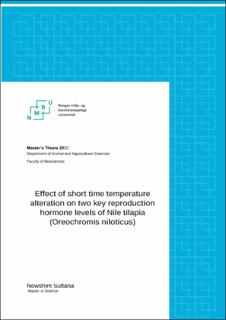| dc.description.abstract | This study investigates the effects of rapid and short temperature change on the levels of the hormones testosterone and estradiol-17β and the subsequent effect on egg maturation in Nile tilapia (Oreochromis niloticus). The purpose is better synchronisation of a group of Tilapia when applying stripping and controlled reproduction. Short-term temperature manipulation, drop from 280C to 220C for three hours, was applied to 24 female Nile tilapias in glass aquaria. The baseline water temperature was maintained at 28±0.50C, and the temperature alteration was obtained by partly exchange of the aquaria water at day 8 of the experimental period, which lasted for 14 days. Eight control fish were kept at the same temperature (280C) throughout the experiment. Blood serum was collected for hormone analysis at three specific times during the total experimental period: 24 hours after spawning, after temperature alteration, and immediately before stripping. The fish were fed 1% of their body weight, 2 times a day, with a 12/12 hrs photoperiod. The groups of Tilapia that were tested were on average 800 g. Number of fertilised eggs were counted. Also, the length and width of sample eggs from each fish were measured, along with number of unfertilised/dead eggs. Finally, the numbers of hatched fry were counted manually and fry with deformities were recorded and sorted out. Changes of testosterone and estradiol-17β levels in blood serum were examined by immunoassays.
The results show that both the estradiol-17β level and the testosterone level were significantly higher (P<0.01) in treated fish than in the control group at the time of stripping. Also, most of the fecundity parameters measured did improve by temperature treatment, especially egg mass, which increased with almost 30%, and the reduction in deformities was ca 40%, both differences being significant (P<0.05). The results observed in the experiment show that the manipulation of an environmental factor (temperature) could be significant for greater control on fry production of Nile tilapia. | en_US |

